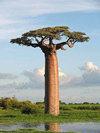法国探险家对中亚植物研究的贡献:纪尧姆·加普斯的植物标本馆收藏(1857-1931)
IF 0.6
4区 生物学
Q4 PLANT SCIENCES
引用次数: 0
摘要
纪尧姆·加普斯(Guillaume Capus)在1880年至1887年间对中亚的考察,特别是在巴黎植物标本馆保存了大约3000份植物标本室标本。他第一次探险的集合很快被另一位法国植物学家阿德里安·弗朗歇(Adrien Franchet)在1883-1884年出版的《突厥斯坦植物》(Plants of Turkestan)中发现。作为正在进行的“乌兹别克斯坦植物区系项目”的一部分,我们详尽地研究了Franchet鉴定的植物列表,计算了1387个集合。首先,我们对这些植物进行了分类更新,发现Capus收录的植物具有重要的多样性,包括87科375属851种(其中Franchet收录的植物有74个新种和21个新变种)。其次,通过对中亚地区植物标本库的深入研究,鉴定出来自中亚3个国家的被子植物新记录:Phlomoides agraria (Bunge) Adylov, Kamelin & Makhm。吉尔吉斯斯坦产Picris strigosa M.Bieb。(菊科)和龙胆(m.b eib .)产自乌兹别克斯坦的龙胆科龙胆花和鞑靼棘豆(Oxytropis tatarica Hook.f.)& Thomson ex Bunge, Onobrychis arnacantha Bunge(豆科),Pedicularis pynnantha Boiss。(桔梗科);塔吉克斯坦的一种十字花科植物。最后,对Capus所访问过的所有原始收集地进行了澄清和地理参考,并编制了基于gis的Capus物种丰富度和收集密度分布图,从而建立了Capus植物旅行地志,为建立中亚地志奠定了基础。RÉSUMÉ亚洲中部地区的探险家的贡献:纪尧姆·卡普斯(1857-1931)。《纪尧姆亚洲中心探索》(1880年至1887年),并没有关于“3000 spsamimcimens d'herbiers, toujours conservacims dans l'Herbier de Paris”(法国)的收藏记录。1883-1884年,法国植物学家阿德里安·弗朗切特(Adrien Franchet)出版了《土耳其斯坦的植物》(Plantes du Turkestan)。在“乌兹巴姆斯坦法洛尔项目”的基础上,我们列出了一份清单,列出了与弗朗切特有关的所有与乌兹别克斯坦有关的所有与乌兹别克斯坦有关的所有与乌兹别克斯坦有关的所有与乌兹别克斯坦有关的所有与乌兹别克斯坦有关的所有与乌兹别克斯坦有关的项目。除此之外,我们的研究还发现,我们的研究主要集中在植物的分类上,我们的研究主要集中在87个家族、375个类型和851个品种(包括74个新品种和21个品种)。Ensuite, notre -。(Lamiaceae) pour le Kyrgyzstan, Picris strigosa M.Bieb。(菊科)及龙胆(m.b eib .)龙胆科龙胆科龙胆属植物;& Thomson ex Bunge, Onobrychis arnacantha Bunge(豆科),Pedicularis pynnantha Boiss。(桔梗科)等。(芸苔科)。最后,我们已经沉积的本地人原始de recoltes看卡布斯,常识les我们georeferencees,等我们编译一个菜单三硝基甲苯炸药des recoltes et de la richesse specifique rassemblees卡布斯,依照ainsi creant联合国gazetter du航行botanqiue de卡布斯前奏用品gazetter d 'Asie舟状骨。本文章由计算机程序翻译,如有差异,请以英文原文为准。
Contribution of French explorers to the study of Middle Asian flora: the herbarium collections by Guillaume Capus (1857-1931)
ABSTRACT Guillaume Capus' expeditions to Middle Asia between 1880 and 1887 resulted especially in an outstanding collection of about 3000 herbarium specimens still kept in the Paris herbarium (France). Gatherings of his first expedition were quickly identified by another French botanist, Adrien Franchet, in ‘Plants of Turkestan’ published in 1883-1884. As part of the ongoing ‘Flora of Uzbekistan project’, we exhaustively studied the list of plants identified by Franchet, counting 1387 gatherings. First, we updated the taxonomy for all of them and found that the plants collected by Capus represent an important diversity made of 87 families, 375 genera, and 851 species (including 74 new species and 21 new varieties described by Franchet). Second, an in-depth study of herbaria from Middle Asia led to identify seven new records of angiosperm species for three Middle Asian countries: Phlomoides agraria (Bunge) Adylov, Kamelin & Makhm. (Lamiaceae) for Kyrgyzstan, Picris strigosa M.Bieb. (Asteraceae) and Gentianella umbellata (M.Bieb.) Holub (Gentianaceae) for Uzbekistan, and Oxytropis tatarica Hook.f. & Thomson ex Bunge, Onobrychis arnacantha Bunge (Fabaceae), Pedicularis pycnantha Boiss. (Orobanchaceae), Matthiola flavida Boiss. (Brassicaceae) for Tajikistan. Third and last, we clarified all original collections localities visited by Capus, georeferenced them, and compiled a GIS-based distribution map for the species richness and collection density, thus creating a gazetter of Capus’ botanical travel and laying the foundation for a gazetter of Middle Asia. RÉSUMÉ Contribution des explorateurs français à l'étude de la flore de l'Asie Centrale: les collections d'herbier de Guillaume Capus (1857-1931). Les explorations de Guillaume Capus en Asie Centrale entre 1880 et 1887 ont notamment abouti à une collection remarquable de 3000 spécimens d'herbiers, toujours conservés dans l'Herbier de Paris (France). Les récoltes de sa première exploration ont été rapidement déterminées par un autre botaniste français, Adrien Franchet, dans ‘Plantes du Turkestan' publié en 1883-1884. Dans le cadre du projet de ‘Flore d'Ouzbékistan’ en cours, nous avons étudié exhaustivement la liste des plantes déterminées par Franchet, en dénombrant 1387 récoltes. D'abord, nous avons mis à jour la taxonomie pour toutes ces récoltes, et trouvé que les plantes récoltées par Capus représntent une diversité importante consistant en 87 familles, 375 genres, et 851 espèces (incluant 74 espèces nouvelles et 21 variétés décrites par Franchet). Ensuite, notre étude approfondie des herbiers d'Asie Centrale conduit à identifier sept nouveaux signalement d’espèces d’angiospermes pour trois pays d’Asie Centrale: Phlomoides agraria (Bunge) Adylov, Kamelin & Makhm. (Lamiaceae) pour le Kyrgyzstan, Picris strigosa M.Bieb. (Asteraceae) et Gentianella umbellata (M.Bieb.) Holub (Gentianaceae) pour l’Ouzbékistan, ainsi que Oxytropis tatarica Hook.f. & Thomson ex Bunge, Onobrychis arnacantha Bunge (Fabaceae), Pedicularis pycnantha Boiss. (Orobanchaceae) et Matthiola flavida Boiss. (Brassicaceae) pour le Tajikistan. Enfin, nous avons élucidé toutes les localités originales de récoltes visitées par Capus, nous les avons géoréférencées, et avons compilé une carte de densité des récoltes et de la richesse spécifique rassemblées par Capus, créant ainsi un gazetter du voyage botanqiue de Capus, prélude d’un gazetter d’Asie Centrale.
求助全文
通过发布文献求助,成功后即可免费获取论文全文。
去求助
来源期刊

Adansonia
生物-植物科学
CiteScore
1.30
自引率
12.50%
发文量
24
审稿时长
>12 weeks
期刊介绍:
Adansonia is a fast-track and peer-reviewed journal of plant biology, devoted to the inventory, analysis and interpretation of vascular plants biodiversity. It publishes original results, in French or English, of botanical research, particularly in systematics and related fields: morphology, anatomy, biology, ecology, phylogeny, biogeography, etc. All articles published in Adansonia are compliant with the different nomenclatural codes. A copyright assignment will be signed by the authors before publication.
 求助内容:
求助内容: 应助结果提醒方式:
应助结果提醒方式:


